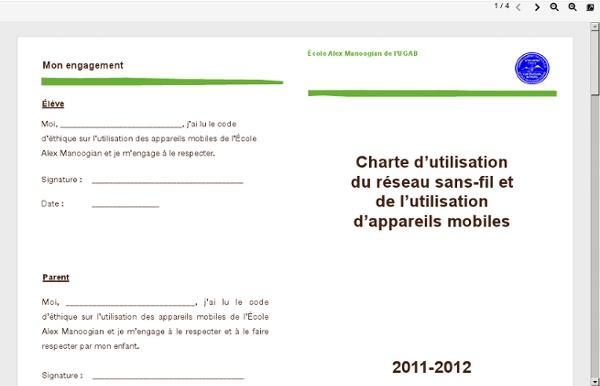



What Teachers Need to Know about BYOD ( Bring Your Own Device ) Trend in Education BYOD is the catch phrase in the 2012 educational technology spheres. This acronym stands for " Bring Your Own Device ", I am pretty sure you might have heard of this new trend because wherever you turn you hear people talking about embracing it. I actually have been reading a lot about it to the point that I deem it important that I share with you some of what I understood from BYOD . Bring Your Own Device or BYOT ( Bring Your Own Technology ) has started in the business world with corporations encouraging their employees to bring their own technology devices such as laptops to use in the work place. This was a strategy to cut down on technology costs and spendings because of the financial crisis the world has witnessed in the recent couple of years. The strategy worked quite well and without even knowing it, it moved to education and so many school districts are embracing it. Advantages of BYOD in education Todays students are digital natives. Myths about BYOD debunked
Politique Charte d’utilisation du réseau sans-fil et de l’utilisation d’appareils mobiles Document de travail élaboré par Sébastien Stasse Dans le cadre de sa mission éducative, l’École Alex Manoogian (ci-appelée École) met à la disposition de ses élèves et de son personnel un réseau sans fil ouvert. L’École souhaite favoriser l’utilisation des ordinateurs et des appareils mobiles appartenant aux élèves et enseignants tout en encadrant cette utilisation par une Charte visant à sensibiliser et à responsabiliser l'utilisateur. La présente Charte s’adresse à tous les utilisateurs du réseau sans fil de l’École ou à tout utilisateur d’appareil possédant son propre accès internet utilisé sur le site de L’École. Tout utilisateur faisant usage d’un tel appareil est réputé avoir accepté la présente Charte d’utilisation du réseau sans fil et de l’utilisation d’appareils mobiles. 1- Accès au réseau sans fil de l’École 2- Cadre d’utilisation 3- Sanctions Delete this content [Debug] <!
The 100 Best Web 2.0 Classroom Tools Chosen By You The Wordle of this list! (Click image to enlarge) One of the most popular posts on Edudemic in 2010 was The 35 Best Web 2.0 Classroom Tools Chosen By You and I felt it might be time for an update to that list for 2011. In order to put together a list of the best Web 2.0 classroom tools, I polled my Twitter followers, Facebook fans (are they still called fans? Likes?) and ran a contest to try and get as many submissions as possible. There were more than 900 submissions but many were duplicates. Bilan projet iPad 2012-2013 Bilan_iPad Voici le bilan de notre première année du projet iPad à la commission scolaire des Affluents. Ce projet est dirigé par Suzanne Dion et Julie Noël conseillères pédagogiques en intégration des TIC et fait partie d’un chantier 7 encadré par Robert David de l’Université de Montréal. L’expérimentation s’est déroulée dans huit classes de trois écoles : Le Castelet, Esther-Blondin, Louis-Joseph-Huot. Les classes visées étaient des classes de 1re à la 5e année du primaire : trois classes au régulier et cinq classes en adaptation scolaire. Un des grands avantages du iPad par rapport à l’ordinateur, à la fois pour l’enseignant et pour l’élève, est de ne pas avoir à se concentrer sur les aspects techniques de l’outil. Voici les défis pédagogiques sur lesquels nous aimerions porter une attention particulière en deuxième année d’expérimentation. Voici les défis techniques auxquels nous travaillons en collaboration avec les techniciens en informatique. D’autres raisons :
Itéractive Plusieurs enseignants mettent en place des pratiques pédagogiques innovantes dans le cadre d’activités d’apprentissage, d’enseignement et d’évaluation. Certaines de ces pratiques sont supportées par les technologies de l’information et de la communication (TIC), visant entre autres à outiller les étudiants et à les faire profiter des possibilités qu’offrent différentes applications web. Ces applications sont issues d’une évolution du web que l’on nomme désormais web social, aussi appelé web 2.0 ou web participatif. Elles sont principalement caractérisées par leurs fonctionnalités permettant des activités de communication, de participation, de collaboration et de partage. L’explosion du nombre d’outils répondant aux caractéristiques du web social ainsi que la popularité grandissante des médias sociaux ont encouragé certains enseignants à expérimenter des activités pédagogiques soutenues par ce type d’outils.
Introduction iPad Erreurs à ne pas commettre Using Dropbox in the Classroom When I mention Dropbox to friends and colleagues, I usually get one of two responses – a knowing smile and nod, or a puzzled and quizzical look. Whether you know what the program is, you have likely heard the name. But really, what is Dropbox? Dropbox is many things — a multifaceted tool that’s so powerful, you’ll continue to discover new ways to use it. How Dropbox works So, how can you use Dropbox as an educator? Additionally, many applications that you likely use (Evernote, Things, 1Password, Elements, to name a few) have a Dropbox sync option. Using Dropbox with students In addition to making your life a lot easier, Dropbox can be a great teaching/learning tool – and this is why I introduce it to my students. You can call this folder anything. Next step: Put your mouse over the folder and click on the arrow to the right – a drop-down menu will appear. Next, you will get the window shown below. Once you have invited students, this becomes a “Shared Folder.” Students catch on quickly
L'ÉCOLE DE DEMAIN | Le blog Education du SE-Unsa Parallèle techno/sociologie